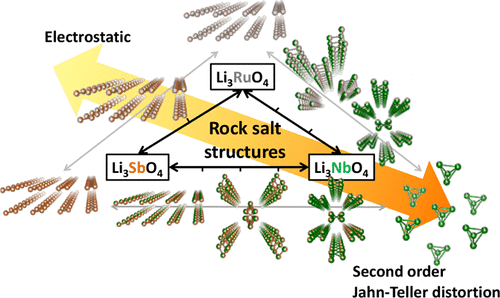当前位置:
X-MOL 学术
›
Chem. Mater.
›
论文详情
Our official English website, www.x-mol.net, welcomes your feedback! (Note: you will need to create a separate account there.)
Electrostatic Interactions versus Second Order Jahn–Teller Distortion as the Source of Structural Diversity in Li3MO4 Compounds (M = Ru, Nb, Sb and Ta)
Chemistry of Materials ( IF 8.6 ) Pub Date : 2018-01-03 00:00:00 , DOI: 10.1021/acs.chemmater.7b04117 Quentin Jacquet 1, 2, 3 , Gwenaëlle Rousse 1, 2, 3 , Antonella Iadecola 3 , Matthieu Saubanère 3, 4 , Marie-Liesse Doublet 3, 4 , Jean-Marie Tarascon 1, 2, 3
Chemistry of Materials ( IF 8.6 ) Pub Date : 2018-01-03 00:00:00 , DOI: 10.1021/acs.chemmater.7b04117 Quentin Jacquet 1, 2, 3 , Gwenaëlle Rousse 1, 2, 3 , Antonella Iadecola 3 , Matthieu Saubanère 3, 4 , Marie-Liesse Doublet 3, 4 , Jean-Marie Tarascon 1, 2, 3
Affiliation

|
With the advent of layered rocksalt oxides showing anionic redox activity toward Li, there has been an increased focus on designing new rocksalt structures and, more particularly, compounds pertaining to the Li3MO4 family. The structural richness of this family is nested in its ability to host many different cations, leading to the formation of superstructure patterns whose predictability is still limited. Thus, there is a need to understand the formation of such superstructures, as cationic arrangements have a crucial effect on their physical properties. Herein we propose a combined experimental and theoretical approach to understand the interactions governing cation ordering in binary systems of general composition given by Li3MyM′1–yO4 (M and M′ being Ru, Nb, Sb, and Ta). Through complementary X-ray diffraction and X-ray absorption spectroscopy techniques, we reveal a solid-solution behavior for the Li3RuySb1–yO4 system, as opposed to Li3SbyNb1–yO4 that enlists four rocksalt structures with different cation orderings. We use DFT calculations to rationalize such a structural diversity and find that it is controlled by a delicate balance between electrostatic interactions and charge transfer due to a second order Jahn–Teller distortion. This insight provides a new viewpoint for understanding cationic arrangements in rocksalt structures and guidelines to design novel phases for applications such as Li-ion batteries or ionic conductors.
中文翻译:

静电相互作用与二阶Jahn-Teller变形是Li 3 MO 4化合物中结构多样性的来源(M = Ru,Nb,Sb和Ta)
随着显示出对Li具有阴离子氧化还原活性的层状岩盐氧化物的出现,人们越来越关注设计新的岩盐结构,尤其是涉及Li 3 MO 4族的化合物。该家族的结构丰富性在于其容纳许多不同阳离子的能力,导致形成了可预测性仍然有限的上层建筑模式。因此,有必要了解这种超结构的形成,因为阳离子排列对其物理性能具有至关重要的影响。本文中,我们提出了一种结合实验和理论的方法来理解由Li 3 M y M'给出的一般组成的二元系统中控制阳离子有序的相互作用1- y O 4(M和M'为Ru,Nb,Sb和Ta)。通过互补的X射线衍射和X射线吸收光谱技术中,我们揭示了用于Li固溶行为3茹ý锑1- ý ø 4系统,相对于Li 3 Sb的ý铌1- ÿ Ò 4列出了四个具有不同阳离子序的岩盐结构。我们使用DFT计算合理化了这种结构多样性,发现它受静电相互作用和电荷转移(由于二阶Jahn-Teller畸变)之间微妙的平衡所控制。这种见解为理解岩石盐结构中的阳离子排列提供了新的观点,并为设计用于锂离子电池或离子导体等应用的新型相提供了指导。
更新日期:2018-01-03
中文翻译:

静电相互作用与二阶Jahn-Teller变形是Li 3 MO 4化合物中结构多样性的来源(M = Ru,Nb,Sb和Ta)
随着显示出对Li具有阴离子氧化还原活性的层状岩盐氧化物的出现,人们越来越关注设计新的岩盐结构,尤其是涉及Li 3 MO 4族的化合物。该家族的结构丰富性在于其容纳许多不同阳离子的能力,导致形成了可预测性仍然有限的上层建筑模式。因此,有必要了解这种超结构的形成,因为阳离子排列对其物理性能具有至关重要的影响。本文中,我们提出了一种结合实验和理论的方法来理解由Li 3 M y M'给出的一般组成的二元系统中控制阳离子有序的相互作用1- y O 4(M和M'为Ru,Nb,Sb和Ta)。通过互补的X射线衍射和X射线吸收光谱技术中,我们揭示了用于Li固溶行为3茹ý锑1- ý ø 4系统,相对于Li 3 Sb的ý铌1- ÿ Ò 4列出了四个具有不同阳离子序的岩盐结构。我们使用DFT计算合理化了这种结构多样性,发现它受静电相互作用和电荷转移(由于二阶Jahn-Teller畸变)之间微妙的平衡所控制。这种见解为理解岩石盐结构中的阳离子排列提供了新的观点,并为设计用于锂离子电池或离子导体等应用的新型相提供了指导。


























 京公网安备 11010802027423号
京公网安备 11010802027423号